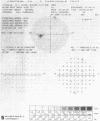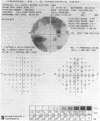Abstract
Humphrey automated threshold perimetry (Program 30-2) was performed on 42 eyes of 25 patients with glaucoma to determine both the sensitivity and specificity of automated perimetry in detecting glaucomatous visual field defects. Automated perimetry sensitivity was 90.38%, while automated perimetry specificity was 91%. Fifty-two patients and a technician took part in a survey to determine their preference for either test. Patients generally preferred having Goldmann perimetry. The technician favoured Humphrey automated perimetry. Program 30-2 on the automated perimeter took 25% longer to perform than Goldmann perimetry.
Full text
PDF




Images in this article
Selected References
These references are in PubMed. This may not be the complete list of references from this article.
- Beck R. W., Bergstrom T. J., Lichter P. R. A clinical comparison of visual field testing with a new automated perimeter, the Humphrey Field Analyzer, and the Goldmann perimeter. Ophthalmology. 1985 Jan;92(1):77–82. doi: 10.1016/s0161-6420(85)34065-4. [DOI] [PubMed] [Google Scholar]
- Heijl A. Computerised perimetry. Trans Ophthalmol Soc U K. 1985;104(Pt 1):76–87. [PubMed] [Google Scholar]
- Heijl A., Drance S. M. A clinical comparison of three computerized automatic perimeters in the detection of glaucoma defects. Arch Ophthalmol. 1981 May;99(5):832–836. doi: 10.1001/archopht.1981.03930010832008. [DOI] [PubMed] [Google Scholar]
- Rock W. J., Drance S. M., Morgan R. W. A modification of the Armaly visual field screening technique for glaucoma. Can J Ophthalmol. 1971 Oct;6(4):283–292. [PubMed] [Google Scholar]





